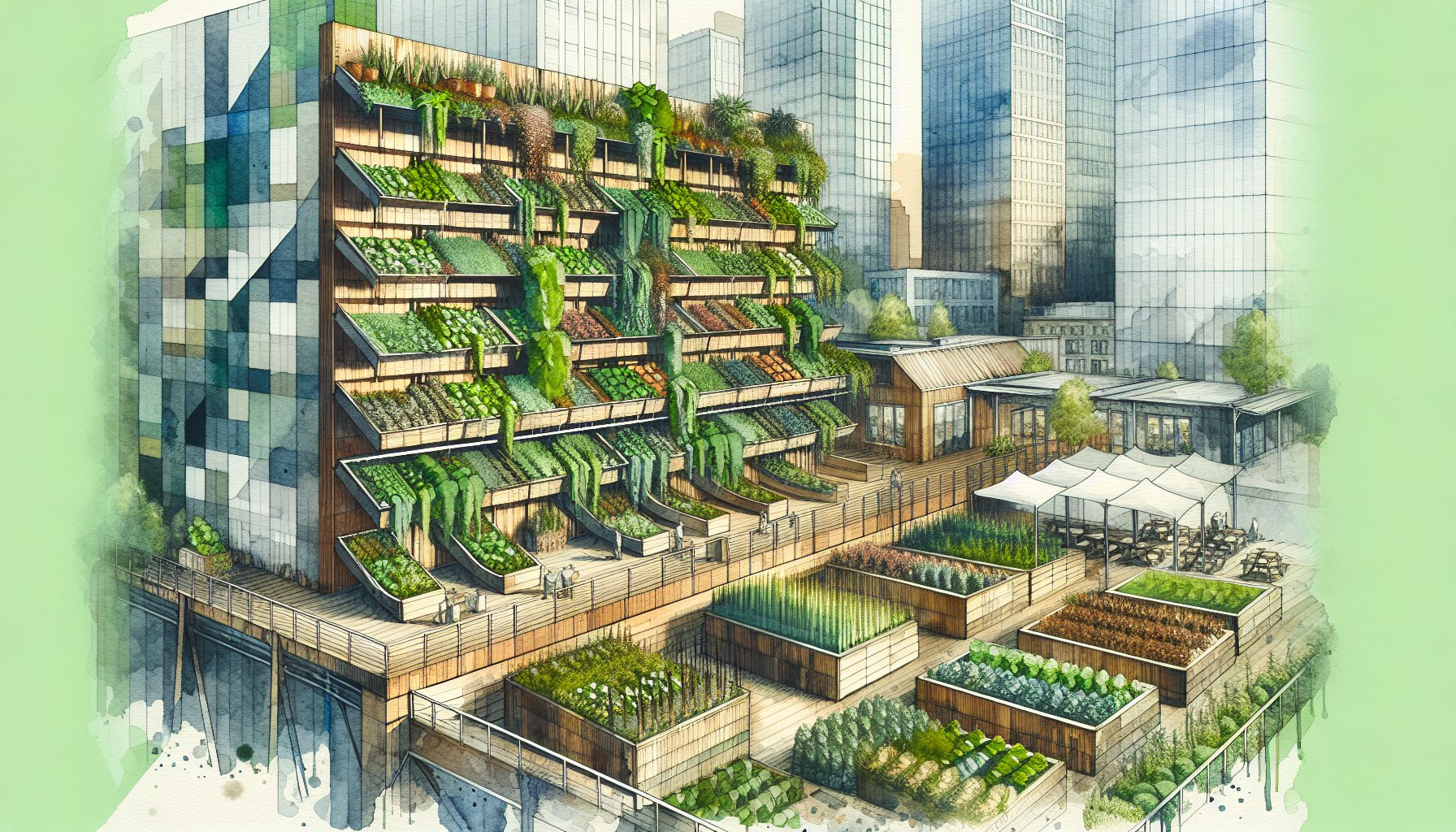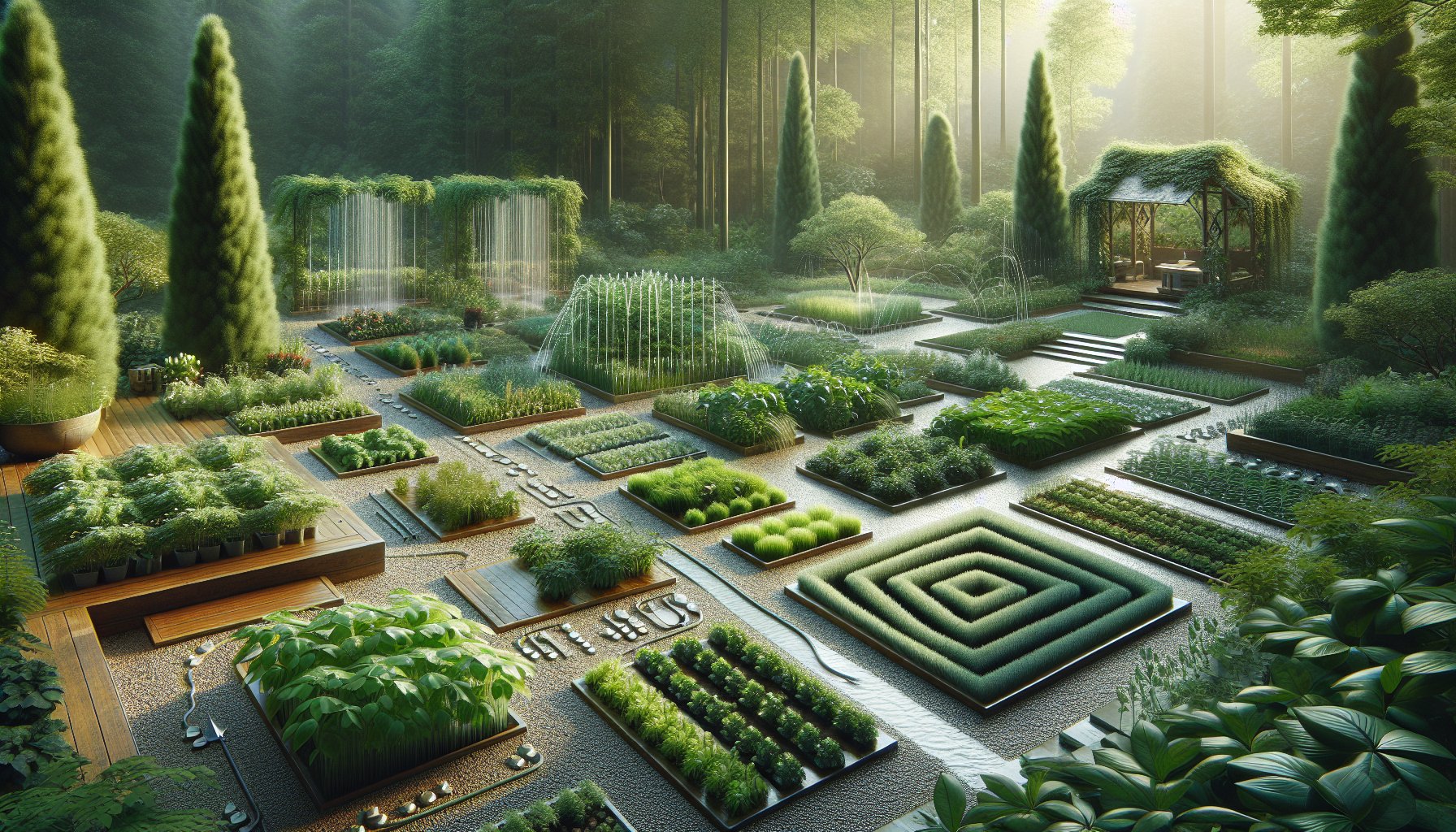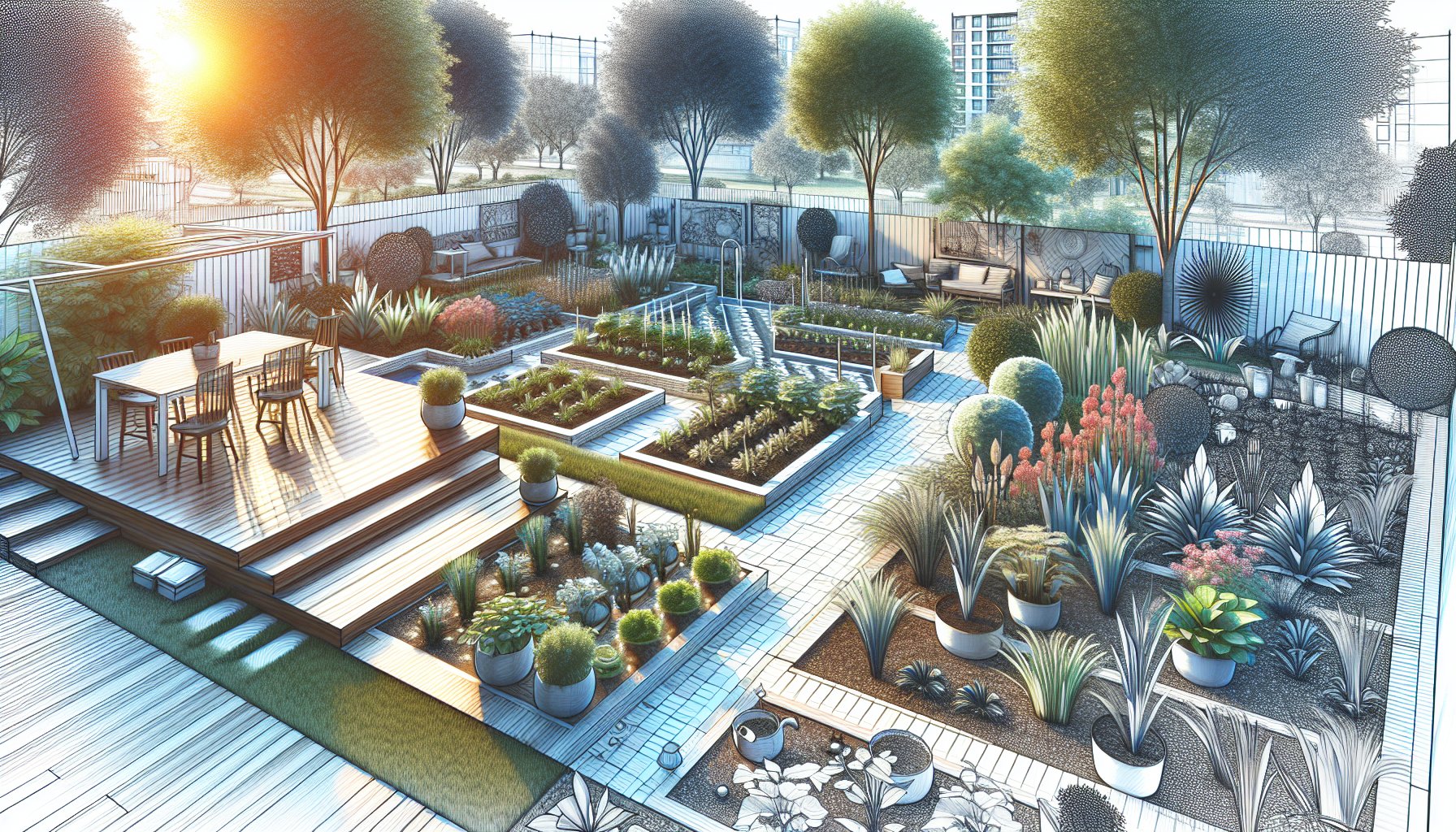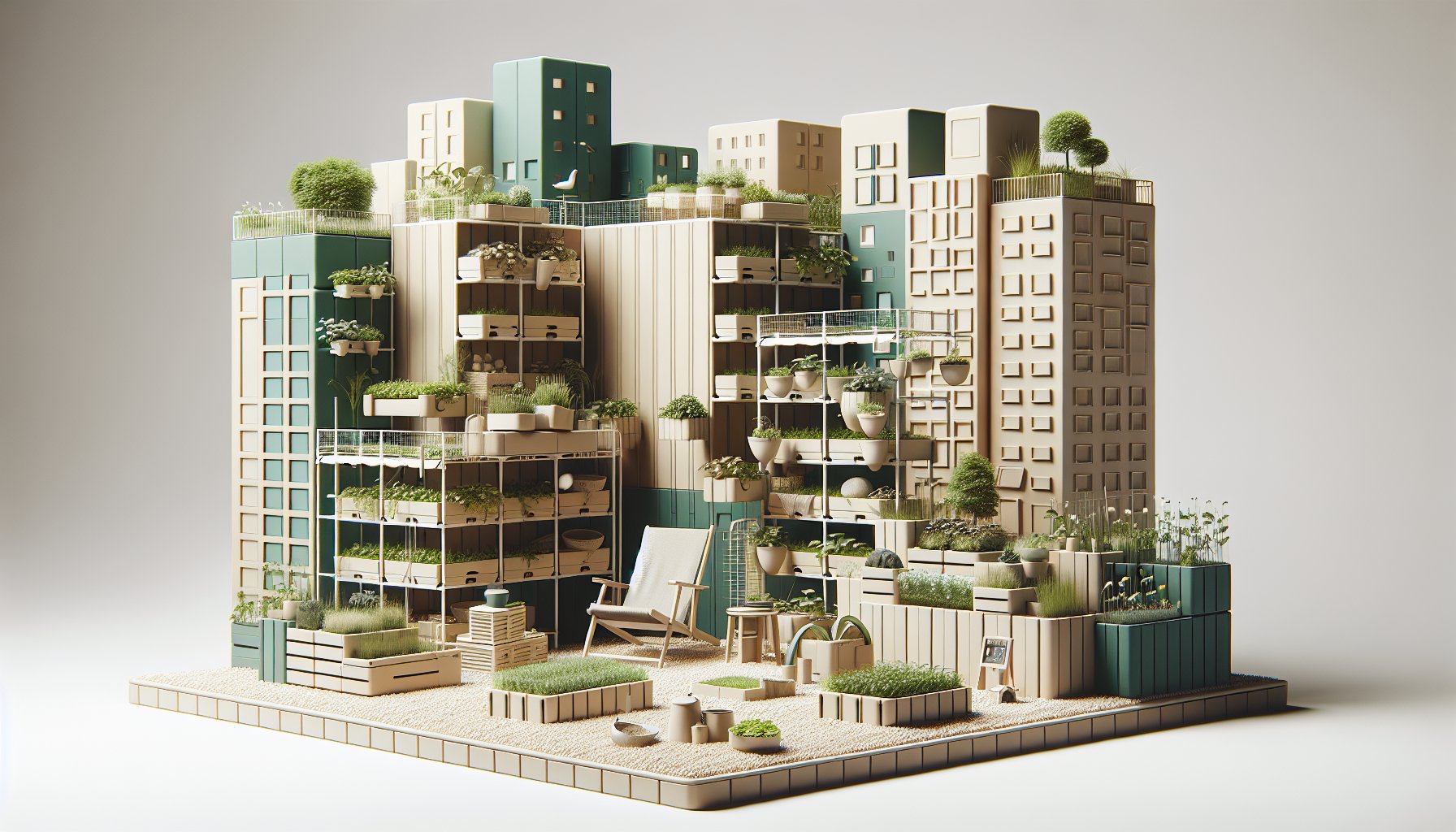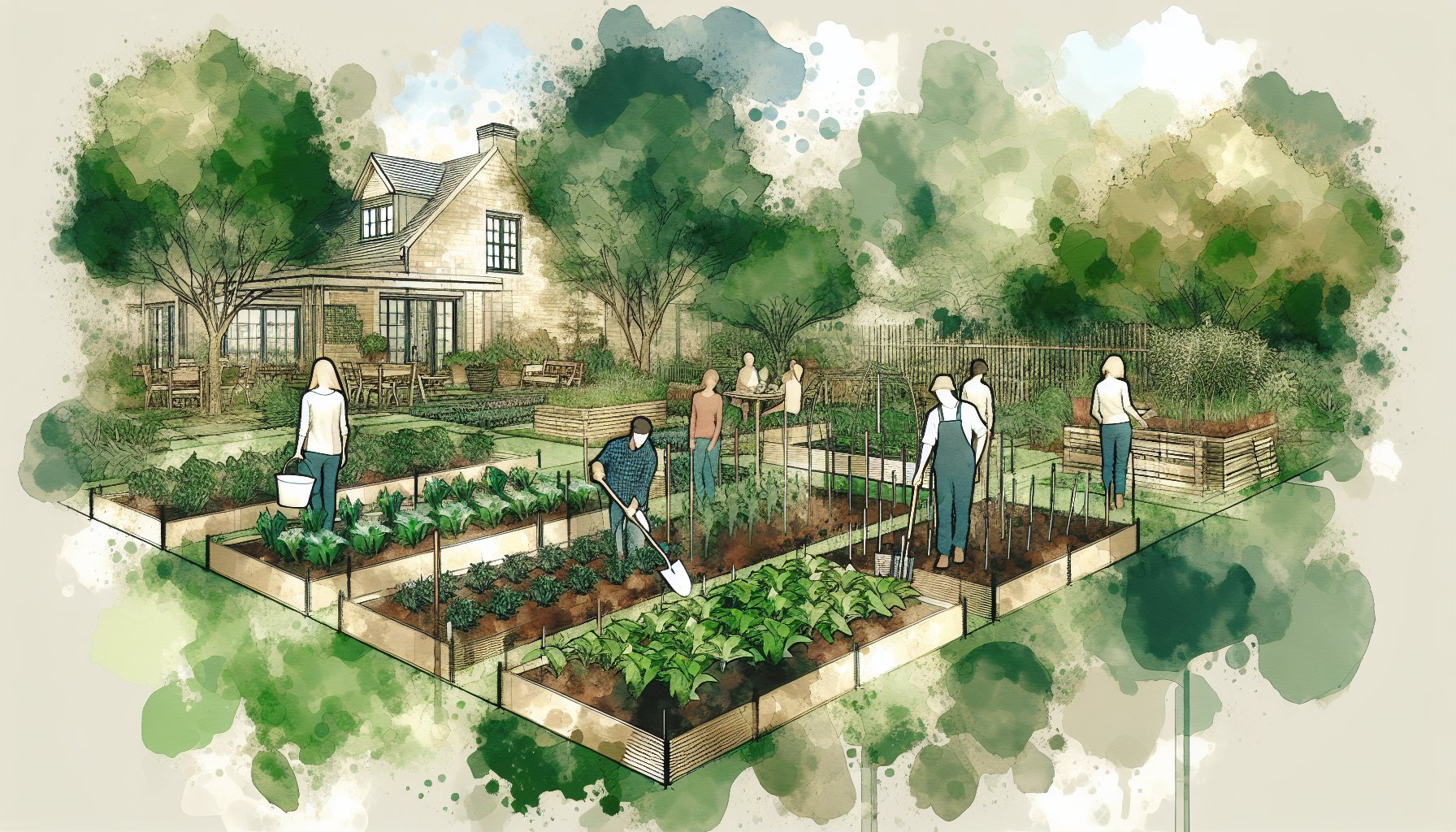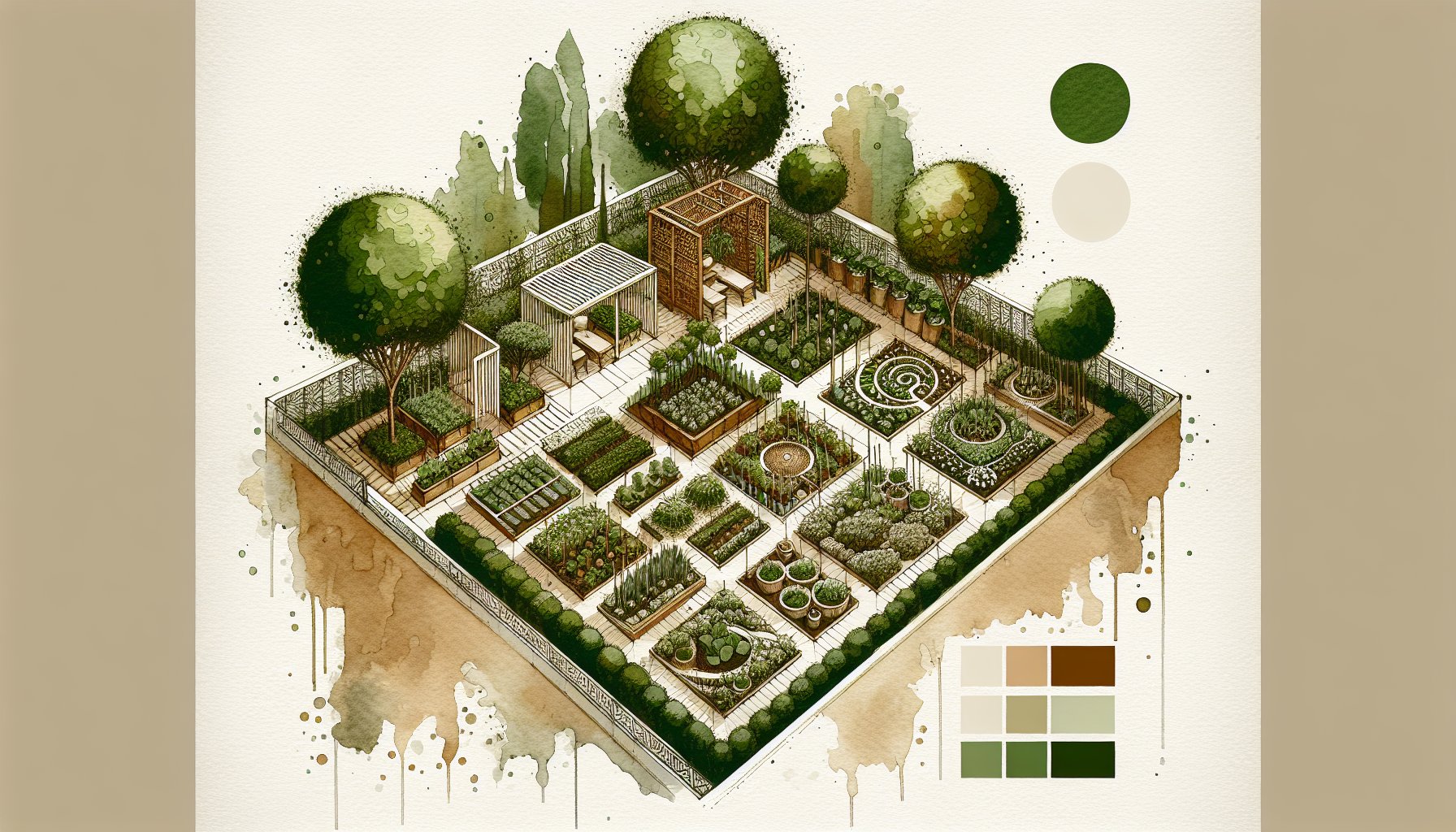Custom Planting Beds
Maximize Space: Vertical Custom Planting Beds for Small Gardens
Discover how to maximize space in your small garden with vertical custom planting beds. Transform your outdoor area into a lush, productive oasis with creative designs and tailored plant selections that enhance beauty and yield.
Sep 07, 2025
17 min read
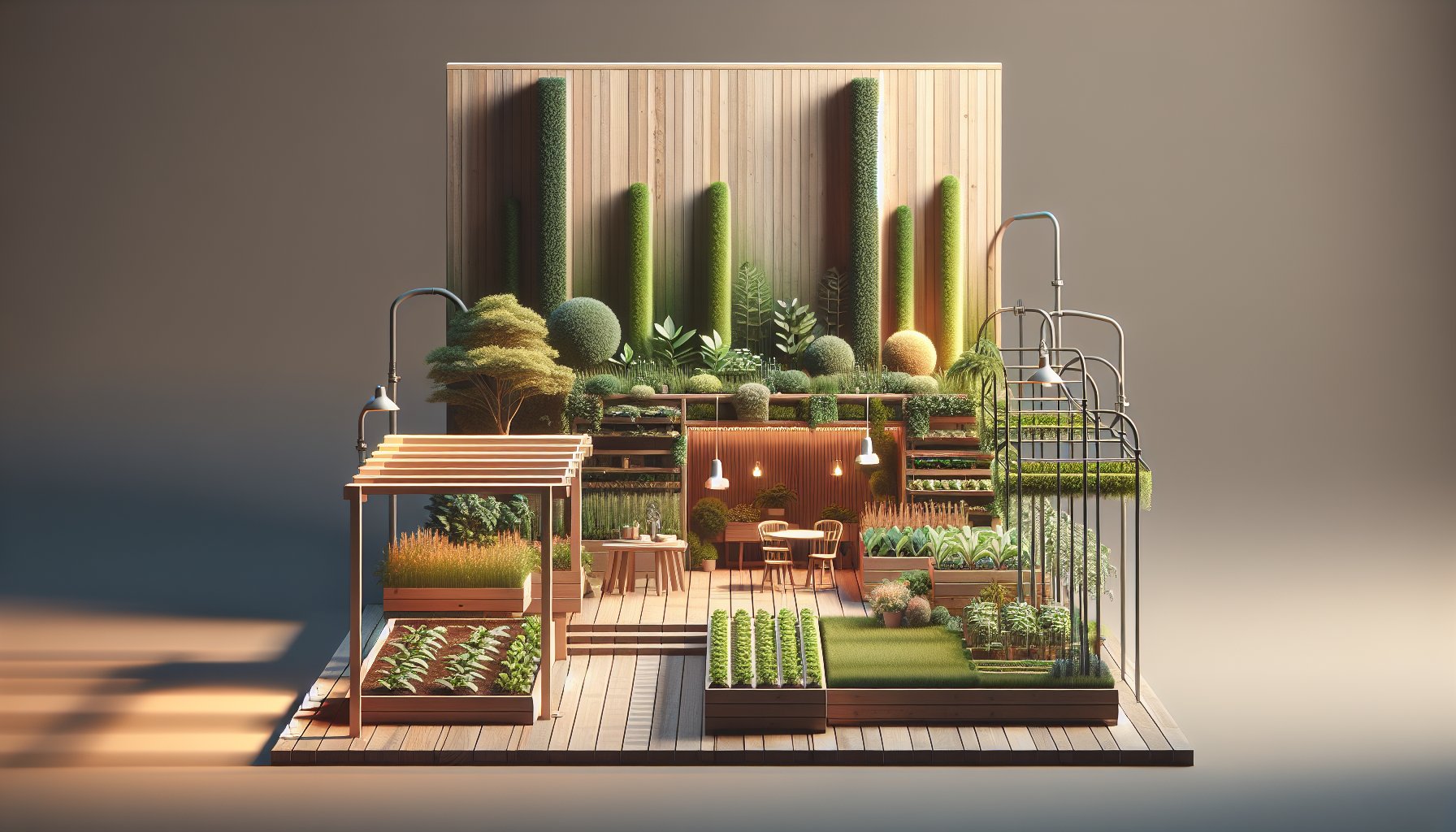
Reaching New Heights: Transforming Small Gardens with Vertical Custom Planting Beds
In the world of gardening, where elbow room is a fleeting dream, vertical custom planting beds emerge as the next big thing. Forget the notion that vertical gardening is just a passing fad; these upward trends invite gardeners to redefine their spaces creatively. For those battling cramped garden plots, vertical systems unlock a treasure chest of opportunities, letting you nurture lush greenery that defies traditional ground rules.
Picture this: a tiny backyard where leafy greens stretch skyward, radiant flowers peek out from every crevice, and aromatic herbs climb gracefully up wooden trellises. It's not just about eye candy; these vertical marvels boost productivity. By cleverly playing with height, you can stack layers of plants, doubling or even tripling your yield within the same footprint. With a pinch of planning and a sprinkle of ingenuity, your garden becomes a diverse playground, attracting pollinators while spicing up your meals.
Consider the case of a petite urban garden where traditional beds are a no-go. Enter a vertical Planting Bed, courtesy of Carson Outdoor Living, transforming a forgotten alleyway into a green sanctuary. Featuring custom-sized planters that reach for the stars rather than hogging the ground, this garden is a vertical feast with cascading herbs, vibrant cherry tomatoes climbing the edges, and strawberries dangling enticingly from above. The clever designs not only make the most of available space but also turn gardening into an immersive experience. Imagine plucking strawberries straight at eye level or fetching fresh basil without bending down.
Customization is key. Tailoring these vertical beds to mesh with your garden’s aesthetic while meeting your specific needs is crucial. Durable materials like rot-resistant wood or recycled plastics ensure longevity, all while keeping Mother Nature happy. You can even design these beds to fit in with varying sunlight conditions, making the shadiest corners of your yard spring to life with strategic plant positioning and selection.
Ultimately, reaching new heights with vertical custom planting beds goes beyond just squeezing more plants into a small space. It's an invitation to reimagine what your garden can be. It's about sparking creativity, inspiring pride, and fostering closer connections to nature. As urban landscapes evolve, innovative gardening solutions become essential. Vertical transformations not only enhance the beauty of small spaces but also celebrate the joy of gardening. Even the tiniest plot can burst with life, color, and flavor. With thoughtful design and a grasp of vertical gardening principles, any small yard can blossom into a thriving ecosystem that's as functional as it is enchanting.
1. Let’s Get Vertical
Let's Dive into The transformative world of vertical gardening, a game-changing strategy for those wrestling with limited space. This approach isn't just about aesthetics; it's a new way of thinking about how we engage with nature, especially in urban settings where outdoor space is gold.
Consider a scenario where someone ditches their bland front lawn for a vibrant vegetable garden. This not only boosts curb appeal but aligns with a growing trend toward sustainable living. And if you're that person’s neighbor, you might get inspired to turn every inch of your outdoor area into a productive green nook. Vertical gardening makes this dream a reality, allowing you to grow a spectrum of edible plants without sacrificing precious ground space.
The magic of vertical gardening comes from using height to create a multi-layered growing environment. By employing trellises, wall-mounted planters, and hanging pots, you elevate your garden into another dimension, boosting your planting capacity. This not only maximizes area but improves air flow, sunlight exposure, and makes maintenance a breeze, essential elements for plant health and productivity.
So, what does this look like in practice? Picture a vertical garden brimming with herbs, tomatoes, and leafy greens in just eight square feet of wall space. It’s not a fantasy, it’s entirely doable. These vertical setups can also serve dual purposes, acting as a stunning focal point while delineating different garden zones. Imagine a cozy dining nook bordered by a vertical herb garden; those aromatic plants would elevate both your meals and the ambiance of your outdoor retreat.
As you start your vertical gardening adventure, embrace best practices for success. Choose plants that thrive in your climate, and consider their light and water needs. Regular maintenance is crucial; ensure adequate support for climbers and watch for pests or diseases. The beauty of vertical gardening lies in its efficiency and its ability to connect you with nature, creating harmony in your limited space.
In conclusion, vertical gardening challenges us to rethink the constraints of tight spaces. By embracing this innovative method, you can create a thriving oasis that adds life, beauty, and productivity to your home. The potential of vertical planting beds is limitless, restricted only by your imagination and willingness to explore the vertical realm. With creativity and planning, those small, overlooked spots can transform into lush landscapes, making Your Outdoor Space a vibrant extension of your home.
2. The Anatomy of a Vertical Garden: Customization at Its Core
In the ever-turning wheel of gardening trends, vertical designs stand out, especially for those tackling spatial challenges. At its heart lies the enchanting concept of customization, an adaptable trait that lets each vertical garden speak the unique language of its creator. Imagine pulling a neglected backyard corner into focus, where possibilities are as varied as the plants themselves. With vertical gardens, you’re not bound by traditional gardening space; you embrace a world where verticality becomes a channel for creativity and efficiency.
Customization starts by understanding your environment. Like a master painter selecting a palette, a gardener must factor in sunlight, wind, and soil types when deciding what to plant. In a small, partly shaded yard, leafy greens and ferns might thrive, while sun-drenched spots can host robust tomatoes or peppers. By choosing plants that are not only pretty but suited to their surroundings, you create a garden that's both functional and beautiful. This mindful approach ensures every inch serves a purpose, allowing the garden to hum with life.
Moreover, vertical gardens encourage imaginative layouts. Picture replacing a traditional fence with a lush vertical garden. Instead of a monotonous backdrop, you introduce a medley of herbs, flowers, and vines, weaving your garden into the very fabric of your outdoor space. This not only boosts curb appeal but also provides fresh ingredients for culinary adventures, showcasing how customization can upgrade everyday experiences.
Delving into the practicalities, best practices emerge. Employ a tiered structure, providing varied plant heights, maximizing space, and creating visual depth. Incorporate drip irrigation systems to streamline maintenance and ensure every plant receives adequate nourishment. The beauty of a vertical garden lies not just in its form, but in the personalized choices that breathe life into it, a testament to the gardener's intent.
Ultimately, vertical gardens embody a profound truth about space and design: limited areas can yield endless possibilities. Focusing on customization helps you embrace your environment's unique characteristics, transforming it into a flourishing retreat that reflects your style and needs. Vertical gardens are not just a fleeting trend but a timeless affirmation of creativity that can thrive even in small spaces. As you embark on your gardening journey, let personalization guide you toward a vertical masterpiece that’s unmistakably yours.
3. Soil Science Elevated: The Best Mediums for Vertical Growth
In the world of gardening, soil is the timeless stage upon which all plant life performs. For those leaping into vertical gardening, especially in tight spaces, choosing the right soil medium is crucial. As you scale your gardening ambitions and create vertical custom planting beds, understanding and selecting the best soil mediums profoundly shape your garden's productivity, health, and charm.
Imagine a vertical garden brimming with greens, juicy tomatoes, and fragrant herbs, all stretching skywards against an urban skyline or a cozy backyard wall. This enchanting scene is made possible not just by design but by the soil that nurtures these ambitious plants. Consider soil composition: a high-quality potting mix made from peat moss, vermiculite, and perlite provides ideal aeration, moisture retention, and nutrient availability. This mix ensures that the delicate root systems of vertical plants have the space and nourishment they need to thrive in unconventional growing conditions.
Beyond standard potting mix, innovative options like coconut coir, a sustainable peat substitute, offer excellent moisture retention and aeration. This renewable resource not only supports plant health but also resonates with eco-friendly gardening practices, a trend that strongly aligns with the modern gardener’s ethos. Adding organic compost to your soil mixture can significantly enhance nutrient content and beneficial microbial life, essential for robust plant growth. As compost enriches the soil, it fosters a living ecosystem that encourages healthy root development, especially crucial in vertically stacked environments where plants may be more vulnerable to stress.
Consider a community garden project where neighbors turned an underutilized plot into a vertical oasis. They started with standard soil mediums but soon found that adding a layer of organic matter, like well-rotted manure, boosted plant yield. With every vertical planter filled with this enriched soil, their garden became a testament to mindful soil selection. Their tomatoes reached for the sky, and herbs overflowed, resulting in not just a bounty but a thriving community.
As you plan your vertical garden, also think about water retention capabilities of your soil medium. A balanced soil mix allows water to percolate without losing essential nutrients through leaching. This is particularly important in vertical gardens, where gravity can be a relentless force, drawing moisture downward and leaving upper plants parched. Using water-retentive crystals or natural elements like expanded clay pebbles creates a moisture reservoir to protect against vertical growth challenges.
To maximize your vertical custom planting beds’ potential, treat soil science as the backbone of your gardening endeavors. With the right soil mix tailored to your plants’ needs, your vertical garden will rise and thrive, showcasing a lush tapestry of colors and textures that invites admiration and inspires others to explore small-space gardening's endless possibilities.
4. The Right Fit: Choosing Your Vertical Planting Bed Design
Choosing the right design for your vertical planting bed goes beyond aesthetics; it's about creating a harmonious balance that aligns with your gardening goals and the constraints of your small space. Vertical gardening opens a treasure trove of possibilities, especially in compact outdoor areas where every inch counts. When imagining your ideal vertical planting bed, consider not just what you want to grow, but how the design will mesh with existing elements in your outdoor haven.
The crux of vertical gardening is maximizing tight spaces while ensuring your plants flourish. Designers often draw inspiration from nature; think of vines scaling trellises or a forest’s intricate layers. A tiered planting system creates visual interest and allows varied sun exposure and air circulation, both vital for plant health. Consider staggered shelves or pockets to house herbs, veggies, and trailing plants, each thriving in its nook. Thoughtful zoning mimics nature's layers while letting you cultivate diverse varieties within one structure.
Integrating your vertical bed into your garden's layout enhances functionality and aesthetics. If your yard features a cozy patio, placing a tall vertical planter nearby transforms an overlooked corner into a productive green space. The bed becomes not just functional but a striking focal point. Imagine lush greens cascading from above, softening hard edges, adding depth to your urban oasis. This interplay between vertical planting beds and surrounding spaces creates an inviting ambiance, beckoning you to engage with your garden.
Material selection is crucial, too, resonating with both design goals and environmental conditions. Wooden structures exude warmth and can be painted in vibrant hues to add character, while metal frameworks bring a modern touch to contemporary designs. Choosing durable, weather-resistant materials ensures your vertical planting beds withstand the elements, letting you focus on nurturing plants over worrying about upkeep.
As you navigate the decision-making process, remember there's no one-size-fits-all solution. Each garden is unique, with specific microclimates, sunlight patterns, and personal preferences guiding your design choices. Draw inspiration from successful projects, but let your individuality shine through. Your vertical planting bed should serve as a plant home and reflect your journey and small garden’s story. Embrace the creative process, experiment, and enjoy transforming your space into a verdant retreat.
Highlight different styles of vertical planting beds tailored to various gardening goals
In small gardening spaces, vertical planting beds are a transformative solution marrying functionality, aesthetics, and creativity. Their appeal lies not just in maximizing space but in catering to diverse gardening goals, each style offering unique benefits tailored to gardeners' desires and needs. From functional herb walls encouraging culinary creativity to floral installations dazzling the eye, vertical planting possibilities are as boundless as one’s imagination.
Take a charming Toronto home where owners dedicated a vertical wall to herbs. Avid cooks, they envisioned a year-round supply of basil, thyme, and rosemary, also serving as an organic backyard focal point. Green hues contrasted beautifully against their rustic red brick home, and the arrangement was designed for ample sunlight. With Carson Outdoor Living's help, they built a tiered vertical planter, each level sloping for maximum light exposure. This installation transformed an overlooked wall into a lush herb haven, blending utility with visual appeal. Not only did they gain direct access to culinary favorites, but they deepened their connection with nature, appreciating homegrown food's value.
Contrast this with vibrant flower cascades installed on a compact urban Vancouver terrace, showing how vertical gardening amplifies small spaces' aesthetic charm. This living wall featured colorful blossoms like trailing petunias and bright geraniums. The goal? Creating an immersive floral experience inviting the community into a world of color and life. Residents passing by were drawn to cascading petals in sunlight, turning the property into a local landmark. Carson Outdoor Living played a pivotal role here, using custom planting pockets for optimal drainage and plant health, letting flowers flourish. This design choice encouraged biodiversity, attracting pollinators and enriching the small ecosystem, achieving a balance between beauty and environmental stewardship.
The enduring lesson: vertical planting beds can meet various gardening goals, from practicality to stunning visuals. Thoughtful, creative design can turn even the smallest outdoor space into a purposeful sanctuary. Understanding specific goals, culinary, visual, or environmental, empowers gardeners to transform limited areas into flourishing vertical retreats. Vertical gardening isn’t just about effective space use; it's about crafting a living narrative reflecting personal taste and lifestyle, inviting nature’s beauty into everyday life.
5. Plant Passion: Selecting the Right Vegetables and Flowers
In gardening's vibrant tapestry, choosing the right vegetables and flowers weaves a small garden into a flourishing retreat. With vertical custom planting beds, plant possibilities are nearly limitless, yet thoughtful selection is crucial. Imagine transforming an underutilized yard corner into an edible oasis or floral wonderland where every plant plays a role, visually and functionally. The key lies in understanding each plant’s characteristics and how they interplay, optimizing vertical space while creating a harmonious aesthetic.
Vertical gardening embraces companion planting's core principles. This ancient technique celebrates certain plants' synergistic benefits. Consider tomatoes, basil, and marigolds: tomatoes thrive with basil support, enhancing flavor, while marigolds repel pests, keeping tomatoes healthy. This combo also introduces height and color layers, creating a visually stunning vertical garden that's practical.
Practicality extends beyond aesthetics; the right selection can cater to culinary preferences or seasonal celebrations. Suppose you love cooking with fresh herbs. Incorporate cascading planters filled with thyme, rosemary, and cilantro. These herbs add dish flavor, thrive vertically, need less space, and yield abundantly. Imagine snipping fresh basil for evening pasta, a satisfaction transcending grocery stores.
As you plant, consider your garden’s microclimate, sunlight, moisture, and wind influence what thrives. For shaded corners, choose leafy greens like spinach or kale, and for sunlit spots, opt for sunflowers and peppers. Vertical planting lets you experiment with these microclimates, creating pockets of varied conditions catering to plant needs, a micro-ecosystem.
Best practices for choosing vegetables and flowers include considering growth patterns and maintenance needs. Prioritize complementary plants that match your gardening style and commitment level. If time’s tight, opt for low-maintenance perennials like lavender or echinacea for beauty and fragrance without heavy upkeep. Conversely, if hands-on gardening excites you, nurturing fast-growing radishes or snap peas is rewarding.
In conclusion, picking the right vegetables and flowers for vertical planting beds is an art combining creativity, practicality, and plant dynamics understanding. Whether your goal is culinary delight, aesthetic pleasure, or gardening joy, every choice enriches your small garden. Embrace planting creativity; let colors and textures inspire you, and watch your vertical garden become a sanctuary of growth and beauty, maximizing every space inch.
6. The Art of Arrangement
The art of plant arrangement in small gardens transcends aesthetics; it addresses our desire to cultivate beauty while maximizing resources. In gardening, especially within small spaces, plant arrangement isn’t just about utility. It’s about crafting a harmonious environment inviting functionality and serenity. Using vertical custom planting beds, you can utilize limited space efficiently while crafting an inviting atmosphere reflecting personal style and purpose.
Effective arrangement centers on layering and zoning principles, letting gardeners create depth and interest, transforming a flat expanse into a vibrant tapestry. In a small backyard, the vertical plane is your ally, drawing the eye upward while freeing ground space. Picture a tiered system where cascading vines spill elegantly from the top, while sturdy vegetables anchor ground level. This optimizes sunlight exposure, creating a lush, multi-dimensional look that feels expansive.
Practical examples include urban gardeners transforming small plots into thriving ecosystems. One family, with limited space, replaced traditional beds with a vertical garden wall. They arranged a mix of herbs, leafy greens, and edible flowers, maximizing yield and creating a charming focal point admired by neighbors.
For arrangement success, consider best practices combining aesthetic appeal with function. Begin with a vision for each garden section. Will it grow food or include relaxation spaces? Use complementary furniture and accessories, like storage-doubling benches or boundary-making raised beds. This intentionality fosters purpose, turning every inch into a meaningful whole part.
Ultimately, the art of small garden arrangement is about more than plants; it’s about crafting a narrative reflecting lifestyle and aspirations. Through careful planning and creativity, transform a small yard into a vibrant sanctuary celebrating nature and design, an intimate retreat inviting exploration and enhancing everyday beauty. As you embark on this journey with vertical custom planting beds, remember each arrangement tells a story, bringing gardens to life.
7. Watering Wisdom: Efficient Irrigation Techniques for Vertical Gardens
In gardening, particularly with vertical planting beds, one vital element reigns supreme: water. Your plants' well-being hinges on efficient irrigation techniques, especially in small gardens where space is a luxury. Think of watering not just as a routine task but as an art that transforms plant growth, health, and yield. As we explore irrigation strategies for vertical gardens, we draw from seasoned gardeners' intuitive approaches.
Picture your beautifully arranged vertical garden, brimming with lush greens and vibrant colors. But without a tailored irrigation system, you risk leaving plants thirsty and stressed. Vertical gardening's challenge lies in distributing water evenly across varied heights and depths, fluctuating dramatically in compact setups. That's why many gardeners turn to drip irrigation systems, delivering water directly to plant roots slowly and steadily. This minimizes runoff and ensures deep moisture penetration without saturating foliage, a must for vertical setups.
Prefer a more visually pleasing approach? Consider rain chains and decorative watering cans as garden focal points. Rain chains guide rainwater from roof to garden, serving as functional irrigation and adding artistic flair. Pairing with a rain barrel conserves water and enhances garden sustainability. By capturing and utilizing natural resources, you become your little ecosystem’s steward, making each drop count.
Timing is equally crucial, especially for vertical gardens with different microclimates due to light exposure and air circulation

Need Help?
Check out these related products that can help:

